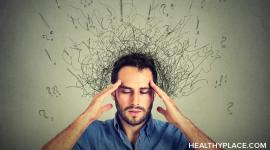Difference Between Positive and Negative Symptoms of Schizophrenia
 Among schizophrenia’s many types of symptoms—cognitive, neurological, behavioral, and emotional—are categories known as positive symptoms of schizophrenia and negative symptoms of schizophrenia. Most schizophrenia symptoms in the DSM-5 fall into these two categories, and it’s the positive symptoms and negative symptoms that are the defining features of the mental illness we call schizophrenia.
Among schizophrenia’s many types of symptoms—cognitive, neurological, behavioral, and emotional—are categories known as positive symptoms of schizophrenia and negative symptoms of schizophrenia. Most schizophrenia symptoms in the DSM-5 fall into these two categories, and it’s the positive symptoms and negative symptoms that are the defining features of the mental illness we call schizophrenia.
Schizophrenia is an illness of the brain with a whole constellation of characteristics. The symptoms represent a range of experiences someone living with this serious mental illness can face. Everyone will possess some combination of symptoms, but no one has all of them (Are Schizophrenia Symptoms in Males and Females Different?).
By definition, schizophrenia involves having some positive symptoms and some negative symptoms. The positive and the negative symptoms exist together and comprise this serious mental illness.
Positive and Negative Symptoms of Schizophrenia Can Be Confusing
The terms “positive” and “negative” can be misleading. They sound like judgments, as if the positive symptoms are good and the negative symptoms are bad. This isn’t the case, however. “Positive” symptoms refer to characteristics that are added to someone’s state of being. “Negative” symptoms, in contrast, are characteristics that are removed from the person’s state of being.
The difference between positive and negative symptoms of schizophrenia is what they do to the person who is living with schizophrenia. Both types of symptoms impact the way he interacts with the world around him and within him. Schizophrenia positive symptoms create distortions and new ways of experiencing the world, while schizophrenia negative symptoms take things away.
Schizophrenia Positive Symptoms
The positive symptoms of schizophrenia involve hallucinations, delusions, disorganized speech, and disorganized or catatonic behavior.
- Hallucinations add things to sensory perceptions. Someone with schizophrenia might see, hear, feel, smell, or taste things that aren’t real.
- Delusions add distortions to someone’s thoughts. She will think and believe things that aren’t logical or real.
- Disorganized speech means that someone’s speech is difficult to follow or understand. He might get off track during a conversation or respond in ways that don’t make sense. Processes added to what usually happens in the brain cause this disorganization and difficulty in communication.
- Disorganized behavior can be erratic, inappropriate, or bizarre. Patterns of interacting with the world are added to her “normal” patterns of interaction.
- Catatonic behavior is withdrawn, can involve unusual positioning of the body, sitting in silence, staring at nothing. As with disorganized behavior, a different behavior pattern has been added to the person’s way of being in the world.
Schizophrenia Negative Symptoms
The negative symptoms of schizophrenia diminish the brain’s ability to process certain experiences and to respond or behave in particular ways. This can lead to:
- Flat affect, where someone can’t show emotion and even the ability to smile is taken away
- Decreased motivation and goal-driven behavior
- Inability to make and pursue goals
- Slowed reaction to other people, events, and happenings
- Diminished speech (instead of disorganized, it is barely there; known as alosia)
- Loss of ability to fully care about people or events (apathy)
- Loss of ability to feel pleasure or happiness (anhedonia)
Someone with schizophrenia experiences some combination of both positive and negative symptoms. Whether they’re positive symptoms of schizophrenia, adding unwanted and unnecessary experiences and characteristics to the person or are negative symptoms of schizophrenia, removing desirable features, these symptoms greatly disrupt someone’s life, how he experiences it, and how he lives it.
APA Reference
Peterson, T.
(2018, March 28). Difference Between Positive and Negative Symptoms of Schizophrenia, HealthyPlace. Retrieved
on 2025, December 7 from https://www.healthyplace.com/thought-disorders/schizophrenia-symptoms/difference-between-positive-and-negative-symptoms-of-schizophrenia


